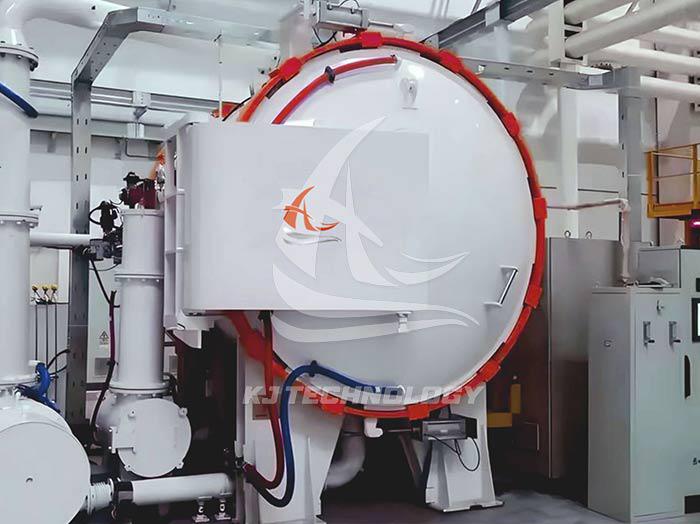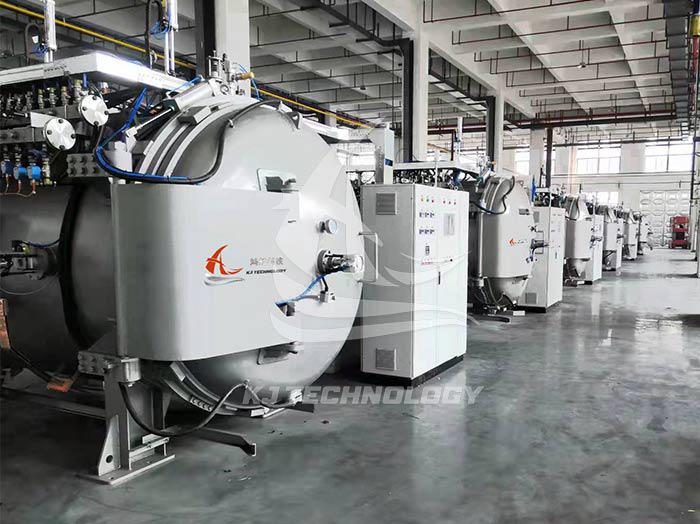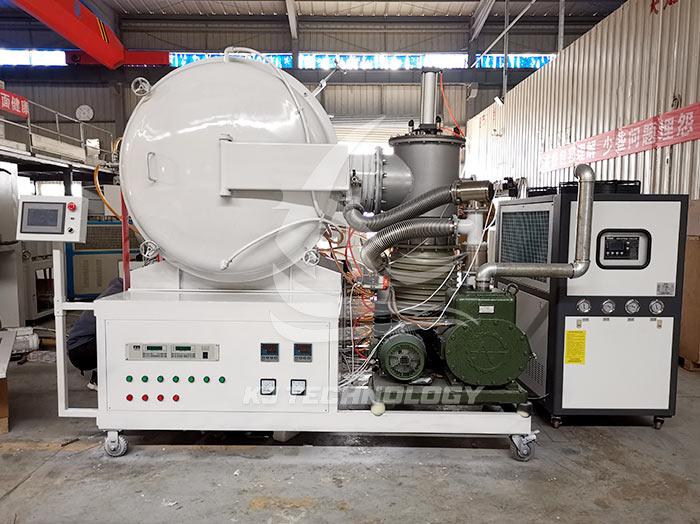Can industrial large vacuum electric furnaces be oil quenched?
 11-14-2025 Author: KJ technology
11-14-2025 Author: KJ technology
Industrial large-scale vacuum electric furnaces can be oil quenched, and vacuum oil quenching technology combines vacuum environment with oil quenching cooling, demonstrating significant advantages in material performance control, deformation suppression, and process adaptability. It has become a key heat treatment solution in the high-end manufacturing field, analyzed from four dimensions: technical principles, equipment support, process advantages, and application scenarios:
1. Technical principle: Implementation of oil quenching cooling in vacuum environment
The vacuum oil quenching furnace completes the quenching process through the following steps:
Vacuum loading: Place the workpiece in a vacuum furnace, evacuate to the target vacuum degree (usually ≤ 10 ⁻ ² Pa), isolate oxygen from other gases, and avoid oxidation reactions.
Heating stage: The workpiece is heated to the quenching temperature through resistance heating, induction heating, and other methods (such as 850-900 ℃ for mold steel and 1200-1260 ℃ for high-speed steel).
Oil quenching cooling: After heating is completed, the workpiece is quickly transferred to a vacuum oil tank, and rapid cooling is achieved through the circulation cooling of quenching oil (such as rapid bright quenching oil, vacuum quenching oil). The oil quenching speed is between water quenching and gas quenching, which can form martensitic structure to improve hardness and reduce deformation risk.
Post processing: According to process requirements, subsequent processing such as tempering and cleaning can be carried out to further improve material properties.
Key point: The vacuum environment completely isolates oxygen to avoid surface oxidation of the workpiece; Oil quenching cooling solves the problem of "hard and brittle" in traditional quenching by reasonably controlling the cooling rate, balancing hardness and toughness.
2. Equipment support: Multi chamber design and dedicated oil quenching system
The oil quenching function of industrial large-scale vacuum furnaces relies on highly integrated specialized equipment, and its core design includes:
Double/Three Room Structure:
Double chamber furnace: The heating chamber and cooling oil tank are isolated by vacuum gates to avoid oil vapor pollution of the heating elements and improve equipment life. For example, a vertical dual chamber vacuum oil quenching furnace is designed with separate upper and lower chambers to achieve independent control of heating and cooling.
Three chamber furnace: Add preparation or pre cooling chambers to further shorten the quenching transfer time (such as controlling the time from the heating chamber to the oil tank within 40 seconds), meeting the quenching needs of thin-walled parts (thickness 3-10mm).
Oil quenching system:
Special quenching oil: It needs to meet the requirements of low steam pressure, high cooling performance, long service life, etc., to avoid affecting the vacuum degree. For example, the evaporation rate of vacuum quenching oil needs to be strictly controlled to reduce the pollution of oil vapor on the furnace.
Oil circulation and stirring: The circulation flow of quenching oil is achieved through an oil pump to accelerate heat transfer; The stirring device can break the steam film, improve cooling uniformity, and reduce workpiece deformation.
Automated control:
Equipped with a programmable temperature control system, it accurately controls the heating temperature, insulation time, and cooling rate. For example, the intelligent vacuum oil quenching furnace developed by Dingli Technology achieves 24-hour unmanned black light continuous production through temperature curve optimization and gas parameter adjustment.
3. Technological advantages: triple improvement of performance, efficiency, and environmental protection
Material performance optimization:
Surface quality: The vacuum environment avoids oxidation and decarburization, and the surface of the workpiece is bright and clean, without the need for subsequent polishing. For example, after vacuum oil quenching, high-speed steel has high surface hardness and no oxide layer, which extends the cutting life.
Mechanical properties: The oil quenching cooling rate is moderate, promoting martensitic transformation while reducing internal stress and improving material toughness. For example, after vacuum oil quenching, the hardness difference between the surface and core of mold steel is controlled within a very small range, and the tensile strength and yield strength are significantly improved.
Dimensional stability: Vacuum degassing removes internal pores in the workpiece, reducing the risk of deformation. For example, thin-walled long rod parts (such as aerospace vertical shafts) have reduced deformation compared to traditional salt bath quenching after being treated in a vertical vacuum oil quenching furnace.
Process efficiency improvement:
Batch processing capability: Dual chamber/triple chamber design enables parallel operation of heating and cooling, shortening production cycles. For example, a three chamber semi continuous vacuum oil quenching furnace can simultaneously process multiple batches of workpieces, meeting the needs of large-scale production.
Process reproducibility: By precisely controlling the heating curve, vacuum degree, and cooling parameters, the performance of each batch of workpieces is ensured to be consistent. For example, the surface layer of the low-pressure carburizing+oil quenching process is uniform, meeting the stringent requirements of high-end manufacturing.
Environmental Protection and Cost Advantages:
Clean production: The oil quenching process does not require the use of water or salt solution, avoiding wastewater discharge pollution; Vacuum environment reduces oil vapor evaporation and reduces corrosion to equipment.
Oil recycling: Quenching oil can be filtered and reused to reduce consumable costs. For example, the service life of vacuum quenching oil is longer than that of ordinary quenching oil.
Energy saving: Vacuum heating reduces heat loss, combined with efficient insulation screen design, resulting in lower energy consumption compared to traditional furnace types.
4. Application scenarios: covering the entire field from aerospace to precision manufacturing
Aerospace:
Processing titanium alloy components (such as aircraft landing gear) and high-temperature alloy parts (such as turbine blades), achieving a balance between high strength and high toughness through vacuum oil quenching. For example, after vacuum oil quenching, the shell of a certain model of missile has high tensile strength, which meets the requirements of extreme working conditions.
Automotive industry:
Used for heat treatment of load-bearing components such as transmission shafts and spring steel to enhance fatigue resistance. For example, after vacuum oil quenching, the uniformity of tooth surface hardness and noise reduction of automotive gears are improved.
Mold manufacturing:
Handle key components such as precision injection molds and stamping molds to extend their service life. For example, after vacuum oil quenching, the lifespan of H13 mold steel is increased from traditional processes to over 500000 cycles.
Cutting tool industry:
Improve the cutting performance of high-speed steel cutting tools. For example, after vacuum oil quenching, the cutting speed of a certain brand of drill bit increases and the tool life is extended.
Energy sector:
Handle high-purity components such as nuclear fuel cladding and electrical insulation materials to avoid impurity contamination. For example, after vacuum oil quenching, the corrosion resistance of nuclear grade stainless steel is improved, meeting the long-term operation requirements of nuclear power plants.








